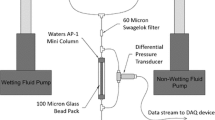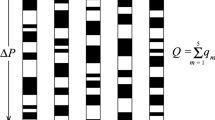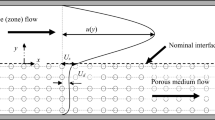Abstract
A comparative experimental study of ‘steady-state’ two-phase flow in two types of model porous media is made to determine the effects of nonplanarity on the flow mechanisms and the mesoscopic flow behavior. The two model porous media have virtually the same pore geometry, but one has a planar network skeleton, whereas the other has a nonplanar (two-layer) skeleton. The latter is a new type of model porous medium that permits detailed visual observation and quantitative measurements without sacrificing the 3D character of the pore network topology. The capillary number and the flowrate ratio are changed systematically, whereas the viscosity ratio and the wettability (contact angle) are kept constant. Conventional relative permeabilities are determined and correlated with the porescale flow phenomena. In the range of parameter values investigated, the flow mechanism observed was ganglion dynamics (intrinsically unsteady, but giving a time-averaged steady-state). The nonplanarity is shown to have small qualitative but significant quantitative effects. In the nonplanar porous medium, the ganglion size distribution is wider, the mean ganglion size larger, and the stranded ganglia are fewer than those in the planar one, under the same flow conditions.
Similar content being viewed by others
Abbreviations
- A i :
-
total cross-sectional area of thei model (i=2D or 3D), m2
- Ca:
-
capillary number, Ca=Μ w v w /σ
- Bo:
-
Bond number, Bo=(ρ w −ρ o )gd 2/4σ
- d :
-
diameter of perpendicular throats, m
- f d :
-
number distribution of depths of etched pores
- f w :
-
fraction of wetting phase in the flowing stream,f w =q w /(q w +q o
- g :
-
acceleration of gravity, m/s2
- k i :
-
absolute permeability (i=2D or 3D), m2 or Darcy
- k ro :
-
relative permeability of nonwetting phase
- k rw :
-
relative permeability of wetting phase
- l :
-
length of periodicity (node-to-node distance), m
- L :
-
distance of the pressure taps along the pore network, m
- p c :
-
capillary pressure, Pa
- q o :
-
flowrate of nonwetting phase, m3/s
- q w :
-
flowrate of wetting phase, m3/s
- r :
-
flowrate ratio,q o /q w
- S :
-
mercury saturation
- S o :
-
‘steady-state’ nonwetting phase saturation
- S′ o :
-
modified ‘steady-state’nonwetting phase saturation
- S w :
-
‘steady-stat’ wetting phase saturation
- x :
-
Cartesian coordinate, direction of macroscopic flow
- δp :
-
pressure drop, Pa
- θ :
-
equilibrium contact angle, measured in aqueous phase
- κ :
-
viscosity ratio,κ=Μ o /Μ w
- Μ o :
-
viscosity of nonwetting phase, Pa s
- Μ w :
-
viscosity of wetting phase, Pa s
- ρ o :
-
density of nonwetting phase, kg/m3
- ρ w :
-
density of wetting phase, kg/m3
- σ :
-
interfacial tension, N/m
- 2D:
-
planar or two-dimensional or one-layer
- 3D:
-
non-planar or three-dimensional or two-layer
- ro :
-
relative to nonwetting phase
- rw :
-
relative to wetting phase
- o :
-
nonwetting (oleic) phase
- w :
-
wetting (aqueous) phase
References
Amaefule, J. O. and Handy, L. L., 1982, The effects of interfacial tensions on relative oil/water permeabilities of consolidated porous media,Soc. Petrol. Eng. J. (June), 371–381.
Avraam, D. G., and Payatakes, A. C., 1994, Flow regimes and mechanisms of steady-state two-phase flow in porous media, submitted inJ. Fluid Mech.
Aurialt, J.-L., 1987, Nonsaturated deformable porous media: Quasistatics,Transport in Porous Media 2, 45–64.
Aurialt, J.-L., Lebaigue, O., and Bonnet, G., 1989, Dynamics of two immiscible fluids flowing through deformable porous media,Transport in Porous Media 4, 105–128.
Buckley, S. E. and Leverett, M. C., 1942, Mechanism of fluid displacement in sands,Trans, AIME 146, 107–116.
Chatzis, I., Morrow, N. R., and Lim, H. T., 1983, Magnitude and detailed structure of residual oil saturation,Soc. Petrol. Eng. J. 23, 311–326.
Chen, J. D., 1986, Some mechanisms of immiscible fluid displacement in small networks,J. Colloid Interface Sci. 110, 488–503.
Craig, F. F., 1971,The Reservoir Engineering Aspects of Waterflooding, Society of Petroleum Engineers of AIME, New York.
Dullien, F. A. L., 1979,Porous Media. Fluid Transport and Pore Structure, Academic Press, New York.
Fulcher, R. A., Ertekin, T., and Stahl, C. D., 1985, Effect of capillary number and its constituents on two-phase relative permeability curves,J. Petrol. Tech., (Feb.), 249–260.
Geffen, T. M., Owens, W. W., Parrish, D. R., and Morse, R. A., 1951, Experimental investigation of factors affecting laboratory relative permeability measurements,Petrol. Trans. AIME 192, 99–110.
Honarpour, M. and Mahmood, S. M., 1988, Relative-permeability measurements: An overview,J. Petrol. Tech. (Aug.), 963–966.
Ioannidis, M. A., Chatzis, I., and Payatakes, A. C., 1991, A mercury porosimeter for investigating capillary phenomena and microdisplacement mechanisms in capillary networks,J. Colloid Interface Sci. 143, 22–36.
Johnson, E. F., Bossler, D. R., and Naumann, V. O., 1959, Calculation of relative permeability from displacement experiments,J. Petrol. Tech. (Jan.), 61–63.
Kalaydjian, F., 1987, A macroscopic description of multiphase flow in porous media involving spacetime evolution of fluid/fluid interface,Transport in Porous Media 2, 537–552.
Kalaydjian, F., 1990, Origin and quantification of coupling between relative permeabilities for two-phase flows in porous media,Transport in Porous Media 5, 215–229.
Lefebvre du Prey, E. J., 1973, Factors affecting liquid-liquid relative permeabilities of a consolidated porous medium,Soc. Petrol. Eng. J. (Feb.), 39–47.
Lenormand, R., and Zarcone, C., 1984, Role of roughness and edges during imbibition in square capillaries,Proc. Soc. Petrol. Eng., Paper No. 13264, 59th Ann. Tech. Conf. and Exhibition of the SPE, Houston, Texas.
Lenormand, R., Zarcone, C., and Sarr, A., 1983, Mechanisms of the displacement of one fluid by another in a network of capillary ducts,J. Fluid Mech 135, 337–355.
Li, Y., and Wardlaw, N. C., 1986a, The influence of wettability and critical pore-throat size ratio on snap-off,J. Colloid Interface Sci. 109, 461–472.
Li, Y., and Wardlaw, N. C., 1986b, Mechanisms of non-wetting phase trapping during imbibition at slow rates,J. Colloid Interface Sci. 109, 473–486.
Mahers, E. G. and Dawe, R. A., 1985, Visualization of microscale displacement processes within porous media in EOR. Capillary pressure effect,Proc. 3rd European Meeting on Improved Oil Recovery, Rome, pp. 49–58.
McCaffery, F. G., Bennion, D. W. 1974, The effect of wettability on two-phase relative permeabilities,J. Canad. Petrol. Technol., (Oct.–Dec.), 42–53.
McKellar, M. and Wardlaw, N. C., 1982, A method of making two-dimensional glass micromodels of pore systems,J. Canad. Petrol. Technol. 21, 39–41.
Melrose, J. C. and Brandner, C. F., 1974, Role of capillary forces in determining microscopic displacement efficiency for oil recovery by waterflooding,J. Canad. Petrol. Technol. (Nov.–Dec.), 54–62.
Ng, K. M. and Payatakes, A. C., 1980, Stochastic simulation of the motion, breakup and stranding of oil ganglia in water-wet granular porous media during immiscible displacement,AIChE J. 26, 419–429.
Owens, W. W. and Archer, D. L., 1971, The effect of rock wettability on oil-water relative permeability relationships,J. Petrol. Technol. (July), 873–878.
Payatakes, A. C., 1982, Dynamics of oil ganglia during immiscible displacement in water-wet porous media,Ann. Rev. Fluid Mech. 14, 365–393.
Payatakes, A. C. and Dias, M. M., 1984, Immiscible microdisplacement and ganglion dynamics in porous media,Rev. Chem. Eng. 2, 85–174.
Payatakes, A. C., Ng, K. M., and Flumerfelt, R. W., 1980, Oil ganglion dynamics during immiscible displacement: Model formulation,AIChE J. 26, 430–443.
Peaceman, D. W., 1977,Fundamentals of Numerical Reservoir Simulation, Elsevier, Amsterdam.
Richards, L. A., 1983, Capillary conduction of liquids through porous mediums,Physics 1, 318–333.
Rose, W., 1988, Measuring transport coefficients necessary for the description of coupled two-phase flow of immiscible fluids in porous media,Transport in Porous Media 3, 163–171.
Rose, W., 1990, Coupling coefficients for two-phase flow in pore spaces of simple geometry,Transport in Porous Media 5, 97–102.
Sandberg, C. R. and Gournay, L. A., 1958, The effect of fluid-flow rate and viscosity on laboratory determinations of oil-water relative permeabilities,Petrol. Trans. AIME 213, 36–43.
Tsakiroglou, C. D. and Payatakes, A. C., 1988, An experimental and theoretical study of mercury porosimetry in a pore network model, presented at AIChE 1988 Annual Meeting, Paper No. 120L, Washington D. C., Nov. 27–Dec. 2 (available upon request).
Tsakiroglou, C. D. and Payatakes, A. C., 1990, A new simulator of mercury porosimetry for the characterization of porous materials.J Colloid Interface Sci. 137, 315–339.
Tsakiroglou, C. D. and Payatakes, A. C., 1991, Effects of pore-size correlations on mercury porosimetry curves,J. Colloid Interface Sci. 146, 479–479.
Vizika, O. and Payatakes, A. C., 1989, Parametric experimental study of forced imbibition in porous media,Physico Chemical Hydrodynamics 11, 187–204.
Wardlaw, N. C., 1982, The effects of geometry, wettability, viscosity and interfacial tension on trapping in single pore-throat pairs,J. Canad. Petrol. Technol.,21, 21–27.
Whitaker, S., 1986, Flow in porous media II: The governing equations for immiscible, two-phase flow,Transport in Porous Media 1, 105–125.
Wooding, R. A. and Morel-Seytoux, H. J., 1976, Multiphase fluid flow through porous media,Ann. Rev. Fluid Mech 8, 233–274.
Author information
Authors and Affiliations
Rights and permissions
About this article
Cite this article
Avraam, D.G., Kolonis, G.B., Roumeliotis, T.C. et al. Steady-state two-phase flow through planar and nonplanar model porous media. Transp Porous Med 16, 75–101 (1994). https://doi.org/10.1007/BF01059777
Received:
Revised:
Issue Date:
DOI: https://doi.org/10.1007/BF01059777




